EPoX EP-9U1697-GLi: ULi M1697 Goes Mainstream
by Gary Key on March 15, 2006 12:05 AM EST- Posted in
- Motherboards
Audio Performance
The Realtek ALC-655 AC97 audio codec was tested with the recently released 3.84 driver set. The Realtek DirectSound audio drivers do not support more than 26 hardware buffers and the OpenAL 1.1 drivers do not support more than 23 hardware buffers at this time, so the scores cannot be directly compared to the HDA Mystique 7.1, Realtek ALC-882, and Creative Labs Sound Blaster X-FI audio solutions in the benchmarks. The Realtek OpenAL 1.1 driver increases CPU utilization up to 8% more than the Realtek DirectSound drivers.
If you are a serious gamer, then a dedicated sound card is still a requirement to ensure consistent frame rate averages across a wide variety of games. We noticed in previous testing of our Battlefield 2 and Half Life 2 benchmarks that the Realtek AC97 audio codecs would cause stuttering in intensive scenes. The 3.84 driver release does not have stuttering in our current benchmarks while improving performance across the board.
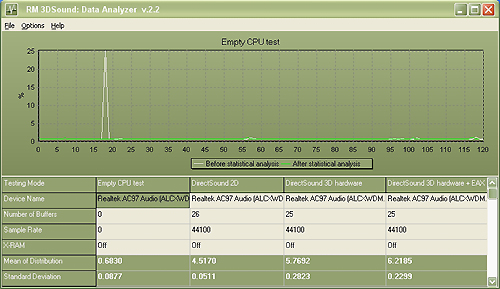
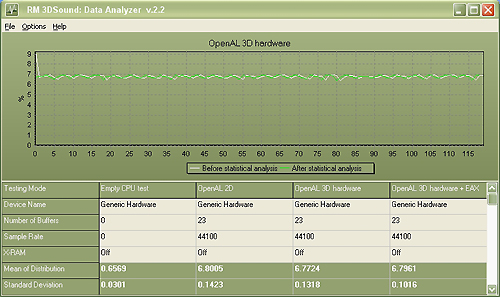
The Realtek ALC-655 AC97 audio codec was tested with the recently released 3.84 driver set. The Realtek DirectSound audio drivers do not support more than 26 hardware buffers and the OpenAL 1.1 drivers do not support more than 23 hardware buffers at this time, so the scores cannot be directly compared to the HDA Mystique 7.1, Realtek ALC-882, and Creative Labs Sound Blaster X-FI audio solutions in the benchmarks. The Realtek OpenAL 1.1 driver increases CPU utilization up to 8% more than the Realtek DirectSound drivers.
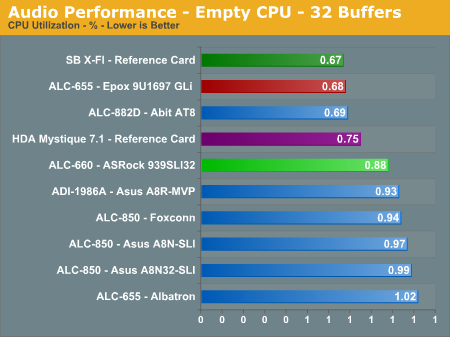
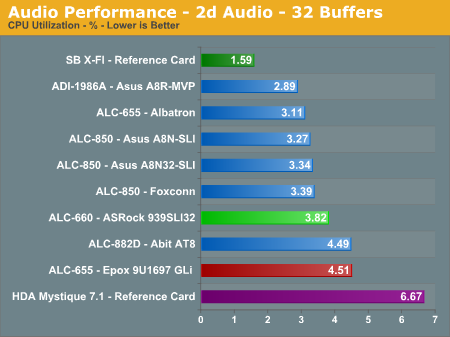
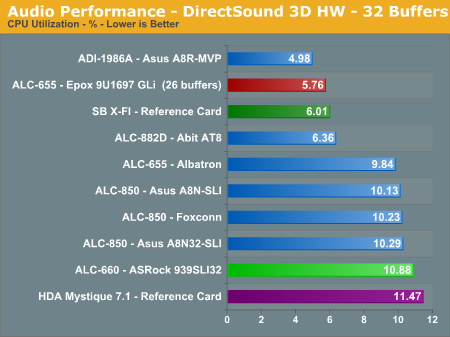
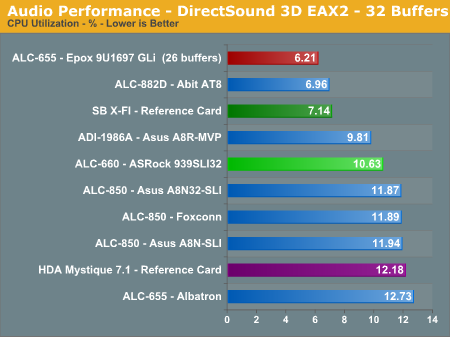
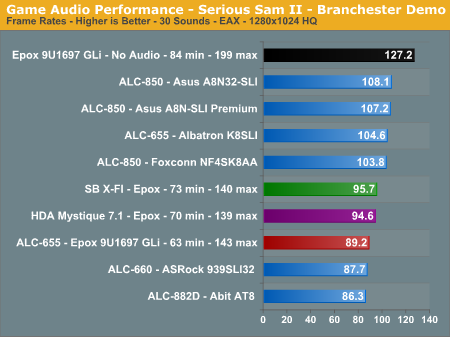
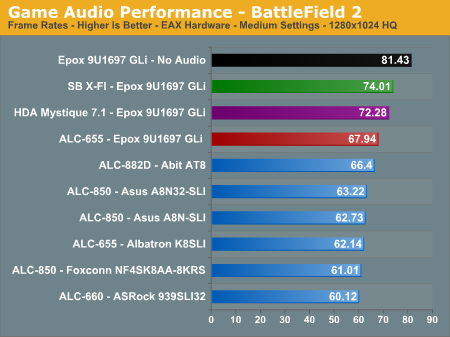
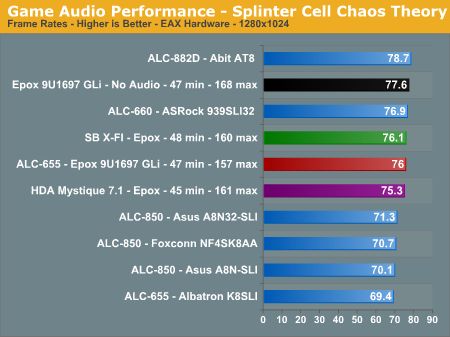
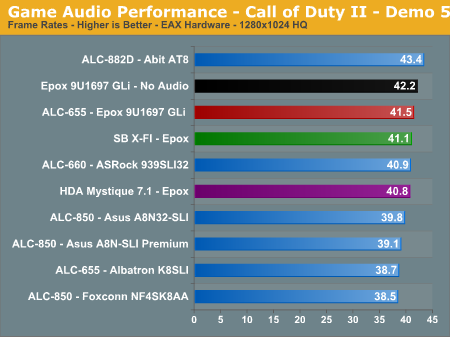
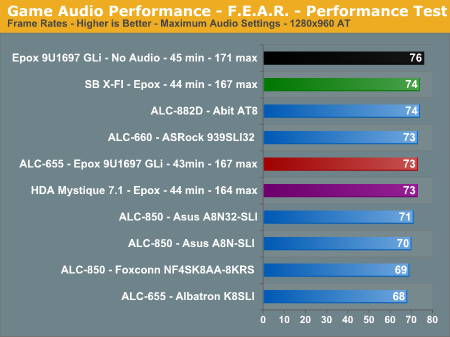
If you are a serious gamer, then a dedicated sound card is still a requirement to ensure consistent frame rate averages across a wide variety of games. We noticed in previous testing of our Battlefield 2 and Half Life 2 benchmarks that the Realtek AC97 audio codecs would cause stuttering in intensive scenes. The 3.84 driver release does not have stuttering in our current benchmarks while improving performance across the board.
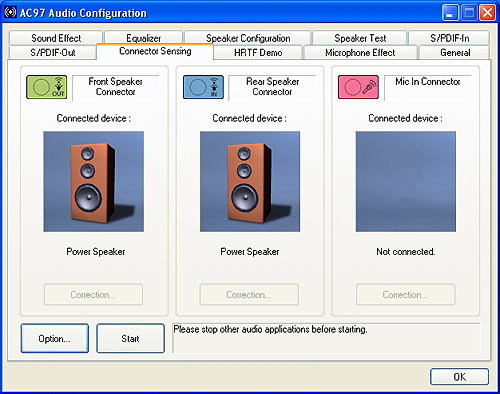
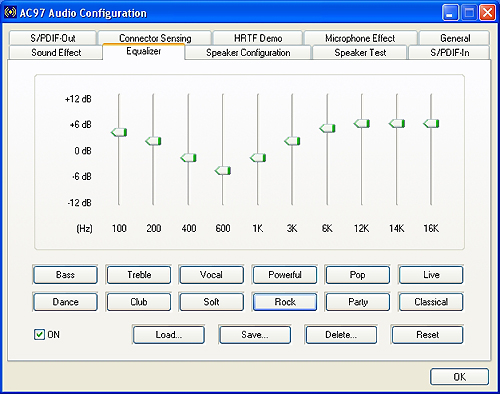










35 Comments
View All Comments
custommadename - Sunday, March 19, 2006 - link
I thought so, but I wanted to make sure. That's great. So this board is pretty much a good overclocking board for a great price. I'm hooked.UJMA - Friday, March 24, 2006 - link
When released the "J " version of this board sports both Gb Ethernet and 8 Channel ALC850 Audio. Look for the EPoX EP-9U1697GLI-J ... I'm definitely getting this mobo.Gary Key - Friday, March 24, 2006 - link
We still do not have confirmation if this model will be released in the US. We certainly have expressed our feelings to EPoX that this is the model that should be offered here. Also, the ALC-850 is not real upgrade from a quality of audio output aspect compared to the ALC-655. We lobbied for the ALC-883 as the cost differential is minimal compared to the ALC-850 but EPoX is betting most people buying the board will upgrade the audio for gaming anyway. We think the ALC-883 would still suffice for the casual gamer and probably for the more serious gamer on a budget from a performance/audio output aspect. It is hard to get excited about a SB X-FI when it cost $30 more than the motherboard in this market segment in our opinion. We think this is still an issue. Overall, the quality of the board is very good and the results speak for themselves.
UJMA - Friday, March 24, 2006 - link
Pretty sure we'll get the "J" version in Europe, "J" versions are available on other Epox models over here. Also glad to see that the Epox board was not unduly handicapped by x8 lane PCI-E as opposed to x16 lane. All in all, even in the bog standard guise, it's a very good board for the money.Good review by the way!
superkdogg - Friday, March 17, 2006 - link
^^^^^^^Those numbers are the initial value the memory will run if the HTT is 200. They all scale based on the HTT speed, so 1:1 = 200. All the other numbers are dividers that allow for running the memory at a ratio speed based on the HTT i.e. 133/200 = 4/6.
custommadename - Friday, March 17, 2006 - link
The memory speeds in the review were Auto, 100 MHz, 133MHz, 160MHz, 200MHz, 218 MHz, 240MHz. Is there a 1:1 setting so that the ram speed increases with the FSB? It would be a shame not to have that seeing as how the ram can be overvoltaged to 3.2Vsuperkdogg - Thursday, March 16, 2006 - link
Hey, this board looks great! The main drawbacks are the two silly component choices: no Gb ethernet and no HD sound (not like Nv boards have this anyway). Since my home network is 10/100 and I'm not an sound freak (and I have some 5.1 digital Live! cards to throw in if need be) those aren't drawbacks.I have a A8R-MVP that rectifies those problems at the cost of high vCore options.....pm me if you want to trade :P
kmmatney - Wednesday, March 15, 2006 - link
Its great having low cost Socket 939 boards, but where are the Socket 939 Semprons?Per Hansson - Wednesday, March 15, 2006 - link
Since Epox has had so many issues in the past with using poor capacitors (sorry I mistyped that, I mean crap capacitors) From GSC and TEAPO I think it deserves a mention that this board is using high quality Sanyo MV-WX capacitors for the VRM section and everything 1000uF and above on the board, and even not cheaping out on the lower value caps by using the top capacitor brand Rubycon for them...And if the editor can not distinguish from a good and bad capacitor brand please atleast post high resolution pictures of the capacitors so people looking for the info will find it without being as wierd as I am and recognize them by the style of their vents and type of colors used ;-)
Gary Key - Wednesday, March 15, 2006 - link
We did make mention on the front page and the features page about the high quality components used on the board. However, we did not specify the brand names or sizes utilized. We will do this in the future if the components selected warrants mention as it would assist the readers without your (not weird) ability to pick out the brand names. I did take a high resolution shot of the capacitors as I surprised by Epox utilizing these on a value board. I should have followed my instincts and posted the shot on the first or last page. Thanks for the comments. :)